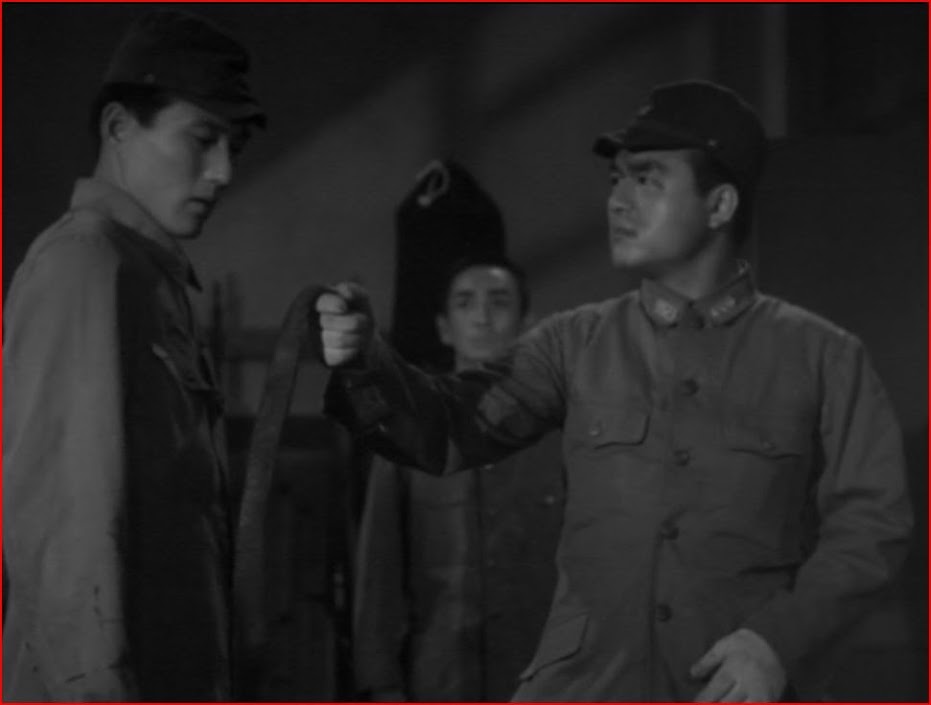

The film focuses on the six occupants of one cell. The two main characters are Yamashita (Torahiko Hamada) and Yokota (Ko Mishima). Yamashita's unit took shelter in a native hut on a South Pacific island late in the war and accepted dinner from its friendly occupant. Yamashita's commanding officer doesn't trust the "savage" not to rat them out to the Allies, so he orders a reluctant Yamashita to kill him. When he's somehow fingered as the killer after the war, Yamashita hopes that his commander will absolve him by admitting responsibility at the trial, but the officer, who soon becomes a peacetime politician, proves a rat and a liar. Yokota is an intellectual who served as a translator in a camp for American POWs. His commander forces him to flog a prisoner who dies soon afterward. Whether for that reason or simply for being a camp guard, Yokota is stuck in prison, where he reads Oscar Wilde's prison writings and causes a scandal when he smuggles news of an escape attempt by Yamashita to his brother, a Communist agitator.


Yamashita longs to take revenge on his old commander, and he seems to get his chance when, despite his escape, he gets a one-day furlough. He confronts the frightened man but sees the face of the native he killed when he thinks of killing another man. Conscience-stricken, and also conscious of the trust his fellow prisoners placed in him, he spares the old officer and closes the picture by telling his buddies, "I'm back."

If you've ever seen the American film noir Act of Violence, think of Yamashita's storyline in Thick-Walled Room like that film told from the point of view of Robert Ryan's avenger rather than Van Heflin's guilty victim.

If Yamashita ends up on the road to readjustment, others aren't so lucky. Another prisoner in the cell is tormented by surrealist dreams of atrocities and finally hangs himself, while Yamashita had only joked of growing a beard -- despite a warning that Americans don't like facial hair -- so he could use it to hang himself. Symbolically, he shaves the beard for his furlough. If Kobayashi himself seems to sympathize with the opinion that the war-criminal prison doesn't purge crimes from humanity, but purges humanity from the crimes, Yamashita's story gives cause for hope, demonstrating that not everyone need be crushed by the ordeal. The Thick-Walled Room is an effective appeal for equitable treatment of Japan's veterans, a plea against killing the spirits of the rank-and-file while the higher-ups make different kinds of killings in the new economy. In his third-directed (though not third-released) film, Kobayashi is stretching his pictorial muscles -- maybe even invoking Citizen Kane when a prisoner sees snow inside a crystal to trigger a flashback -- while keeping the film grounded in the personal stories of the principal prisoners. It ended up one of three 1956 releases for the director now included in the "Masaki Kobayashi Against the System" collection, followed by the baseball drama I'll Buy You and the more noirish-sounding Black River. Look for reviews on this blog in the weeks to come.
"the Shochiku studio shelved Thick-Walled Room for three years from fear of offending the American occupiers"
ReplyDeleteI wonder about that. Japan (except for Okinawa and Iwo Jima) was independent again by the end of April 1952 (in which year one of Kurosawa's wartime films was finally released after the Americans banned it), which I'm presuming was well before Kobayashi started work on this film. What you say about the film really pointing the finger at the Japanese sounds like a more likely reason for Shochiku withholding it.
Mind you, I'm only going on suspicion without evidence one way or the other, and could be wrong, but I do find it odd that Shochiku would be worried about offending the occupying Americans when the Americans weren't occupying the country...
james1511: The peace treaty is acknowledged in the film itself, which is set from approximately 1950 to the present as of filming, as the restoration of Japan's independence, which makes the prisoners even more impatient to be released and the Japanese government more to blame when they aren't.
ReplyDelete